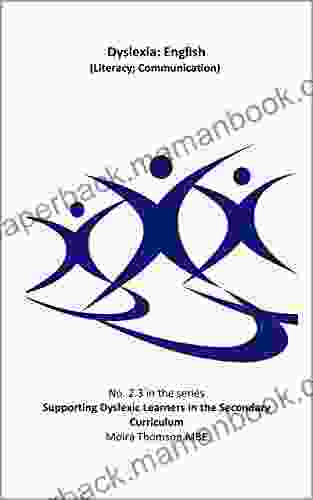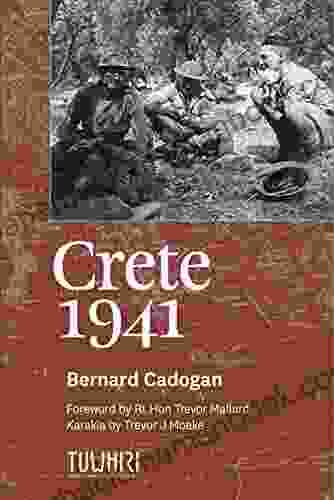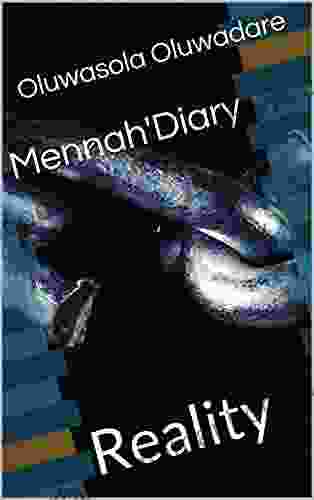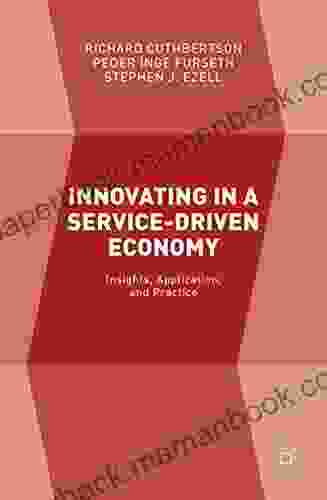English Literacy Communication Supporting Learners With Dyslexia In The United Kingdom

Dyslexia is a specific learning difficulty that affects the way a person processes and understands language. It can make it difficult for people with dyslexia to read, write, and spell. Dyslexia is a common learning difficulty, affecting around 10% of the population.
There are many different ways to support learners with dyslexia in the English literacy classroom. Some of the most effective strategies include:
5 out of 5
| Language | : | English |
| File size | : | 1302 KB |
| Screen Reader | : | Supported |
| Print length | : | 143 pages |
| Lending | : | Enabled |
- Using multi-sensory activities to teach new concepts.
- Providing learners with clear and concise instructions.
- Giving learners extra time to complete tasks.
- Using assistive technology, such as audiobooks and text-to-speech software.
- Providing learners with a supportive and encouraging learning environment.
It is important to remember that every learner with dyslexia is different. What works for one learner may not work for another. It is important to work with each learner to develop a plan that meets their individual needs.
Multi-Sensory Activities
Multi-sensory activities are activities that engage multiple senses, such as sight, hearing, touch, and smell. These types of activities can be particularly helpful for learners with dyslexia because they can help to reinforce new concepts and make them more memorable.
Some examples of multi-sensory activities that can be used to teach English literacy skills include:
- Using sand or play dough to form letters and words.
- Using different coloured pens and markers to write words and sentences.
- Using tactile letters and letter tiles to spell words.
- Using audiobooks and music to learn new vocabulary.
- Using flashcards with pictures and words to learn new concepts.
Clear and Concise Instructions
Learners with dyslexia can often find it difficult to understand complex or confusing instructions. It is important to provide learners with clear and concise instructions that are easy to follow.
Here are some tips for giving clear and concise instructions:
- Use simple language and avoid jargon.
- Break down instructions into small, manageable steps.
- Repeat instructions as necessary.
- Use visual aids, such as diagrams and charts, to supplement your instructions.
- Allow learners to ask questions and clarify any points they don't understand.
Extra Time to Complete Tasks
Learners with dyslexia often need extra time to complete tasks. This is because they may need to read instructions more carefully, process information more slowly, or write more slowly than other learners.
It is important to be patient with learners with dyslexia and give them the extra time they need to complete tasks. You can also help learners to manage their time by breaking down tasks into smaller, more manageable chunks.
Assistive Technology
There are a variety of assistive technology tools that can help learners with dyslexia. These tools can help learners to read, write, and spell more easily.
Some examples of assistive technology tools that can be used in the English literacy classroom include:
- Audiobooks and text-to-speech software
- Word processors with spell-check and grammar-check features
- Talking calculators
- Assistive listening devices
- Screen readers
Supportive and Encouraging Learning Environment
Learners with dyslexia need to feel supported and encouraged in the learning environment. This means creating a classroom culture that is positive and respectful.
Here are some tips for creating a supportive and encouraging learning environment for learners with dyslexia:
- Be patient and understanding.
- Celebrate learners' strengths and efforts.
- Encourage learners to ask questions and seek help when needed.
- Avoid labeling learners as "lazy" or "stupid."
- Work with parents and other professionals to provide learners with the support they need.
Dyslexia is a common learning difficulty that can affect a person's ability to read, write, and spell. However, with the right support, learners with dyslexia can succeed in the English literacy classroom. By using multi-sensory activities, providing clear and concise instructions, giving learners extra time to complete tasks, using assistive technology, and creating a supportive and encouraging learning environment, you can help learners with dyslexia reach their full potential.
5 out of 5
| Language | : | English |
| File size | : | 1302 KB |
| Screen Reader | : | Supported |
| Print length | : | 143 pages |
| Lending | : | Enabled |
Do you want to contribute by writing guest posts on this blog?
Please contact us and send us a resume of previous articles that you have written.
 Top Book
Top Book Novel
Novel Fiction
Fiction Nonfiction
Nonfiction Literature
Literature Paperback
Paperback Hardcover
Hardcover E-book
E-book Audiobook
Audiobook Bestseller
Bestseller Classic
Classic Mystery
Mystery Thriller
Thriller Romance
Romance Fantasy
Fantasy Science Fiction
Science Fiction Biography
Biography Memoir
Memoir Autobiography
Autobiography Poetry
Poetry Drama
Drama Historical Fiction
Historical Fiction Self-help
Self-help Young Adult
Young Adult Childrens Books
Childrens Books Graphic Novel
Graphic Novel Anthology
Anthology Series
Series Encyclopedia
Encyclopedia Reference
Reference Guidebook
Guidebook Textbook
Textbook Workbook
Workbook Journal
Journal Diary
Diary Manuscript
Manuscript Folio
Folio Pulp Fiction
Pulp Fiction Short Stories
Short Stories Fairy Tales
Fairy Tales Fables
Fables Mythology
Mythology Philosophy
Philosophy Religion
Religion Spirituality
Spirituality Essays
Essays Critique
Critique Commentary
Commentary Glossary
Glossary Bibliography
Bibliography Index
Index Table of Contents
Table of Contents Preface
Preface Introduction
Introduction Foreword
Foreword Afterword
Afterword Appendices
Appendices Annotations
Annotations Footnotes
Footnotes Epilogue
Epilogue Prologue
Prologue Michael Weller
Michael Weller Charles Weeden
Charles Weeden Ledys Angola
Ledys Angola John Hagensen
John Hagensen Kim Solga
Kim Solga Maria Hantzopoulos
Maria Hantzopoulos M V Kasi
M V Kasi J T Lewis
J T Lewis Rui Zhi Dong
Rui Zhi Dong John Scotcher
John Scotcher Rachel Hoffman
Rachel Hoffman Nick Duffell
Nick Duffell Talya Rubin
Talya Rubin Nancy Silverton
Nancy Silverton Ger Arevalo
Ger Arevalo Tony Batchelor
Tony Batchelor Julie Clark
Julie Clark Tanya Goodin
Tanya Goodin Ryan Parrott
Ryan Parrott Kim Pearson
Kim Pearson
Light bulbAdvertise smarter! Our strategic ad space ensures maximum exposure. Reserve your spot today!
 Brenton CoxFollow ·7.7k
Brenton CoxFollow ·7.7k Felix CarterFollow ·13.9k
Felix CarterFollow ·13.9k Aaron BrooksFollow ·5.1k
Aaron BrooksFollow ·5.1k Devin RossFollow ·5.2k
Devin RossFollow ·5.2k Banana YoshimotoFollow ·5.8k
Banana YoshimotoFollow ·5.8k Fyodor DostoevskyFollow ·12.8k
Fyodor DostoevskyFollow ·12.8k Aron CoxFollow ·7.2k
Aron CoxFollow ·7.2k Jacques BellFollow ·9.8k
Jacques BellFollow ·9.8k

 Jeremy Mitchell
Jeremy MitchellPlay We Now On Christmas Violin Christmas: A Heartfelt...
Play We Now On...
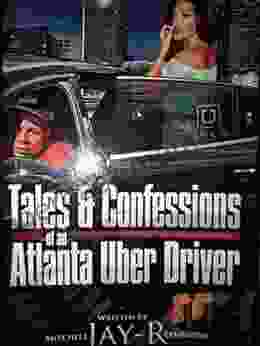
 Terry Bell
Terry BellTales from the Road: Confessions of an Atlanta Uber...
In the vibrant...
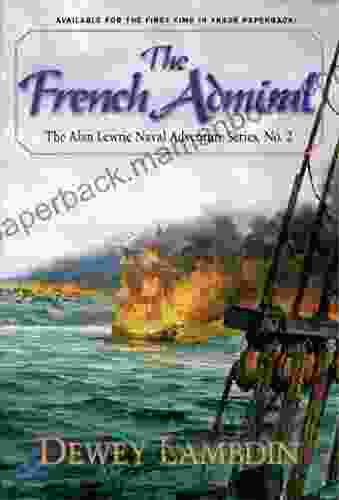
 Ervin Bell
Ervin BellThe French Admiral: A Gripping Naval Adventure with Alan...
In the vast expanse of...

 Henry David Thoreau
Henry David ThoreauCrochet Cozy Afghan Patterns: Crochet Weekend Afghan...
to Crochet...

 Orson Scott Card
Orson Scott CardAn Archaeological View Of The Industrialization Of North...
The industrialization of North America was a...

 Josh Carter
Josh CarterClipboard Christmas Skits by Tom Spence: A Festive...
A Christmas...
5 out of 5
| Language | : | English |
| File size | : | 1302 KB |
| Screen Reader | : | Supported |
| Print length | : | 143 pages |
| Lending | : | Enabled |


